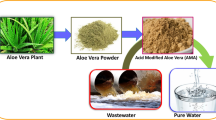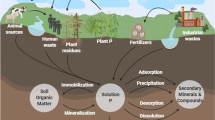Abstract
Recent studies suggest that siderophores form stable complexes with divalent metals and affect their mobility. In this work, effects of trihydroxamate microbial siderophores and desferrioxamine-B (DFOB) on Pb(II), Zn(II), and Cd(II) sorption by two kinds of synthesized zeolites (13X and Na–Y) as a function of pH were investigated. Results showed that 13X zeolite has a higher sorption affinity for studied metals than Na–Y. DFOB strongly affected metal sorption on both zeolites. Under slightly acidic to neutral condition, DFOB increased the metal sorption on zeolites due to the sorption of positively charged heavy metal–DFOB complexes. Whereas by increasing pH (>7), the mobilizing effect of DFOB was observed for Pb, Zn, and Cd. DFOB drastically decreased (80 %) Zn sorption in alkaline condition. As a result, siderophores can weaken the treatment efficiency of zeolites and increase the bioavailability of metals in soils. Surface complexation modeling revealed that the effects of DFOB on metal sorption by 13X and Na–Y zeolites can be explained by the differences in their surface charge. In general, the result shows the influence of DFOB on metal sorption by zeolites over the pH range 4–9 and decreasing in the sequence Zn > Pb > Cd.






Similar content being viewed by others
References
Albrecht-Gray A, Crumbliss AL (1998) Coordination chemistry of siderophores: thermodynamic and kinetics of iron chelation and release. Met Ions Biol Syst 35(35):239–327
Bachmaf S, Merkel B (2011) Estimating water chemistry parameters from experimental data using PEST with PHREEQC. Freiberg online geology (FOG), Freiberg
Boukhalfa H, Crumbliss AL (2002) Chemical aspects of siderophore mediated iron transport. Biometals 15:325–339
Duckworth OW, Sposito G (2005) Siderophore-manganese(III) interactions. air-oxidation of manganese(II) promoted by desferrioxamine B. Environ Sci Technol 39(16):6037–6044
Dzombak DA, Morel FMM (1990) Surface complexation modeling: hydrous ferric oxide. Wiley, Pittsburgh, PA
Edwards DC, Myneni SCB (2005) Hard and soft X-ray absorption spectroscopic investigation of aqueous Fe(III)-hydroxamate siderophores on aqueous solutions. Phys Chem 109(45):10249–10256
Hepistal SE, Turner BF, Mauric PA (2005) Effects of siderophores on Pb and Cd adsorption to kaolinite. Clays Clay Miner 53(6):557–563
Hernlem BJ, Vane LM, Sayles GD (1999) The application of siderophores for metal recovery and waste remediation: examination of correlation for prediction of metal affinities. Water Res 33(4):951–960
Kraemer SM (2004) Iron oxide dissolution and solubility in the presence of siderophores. Aquat Sci 66:3–18
Kraemer SM, Xu J, Raymond KN, Sposito G (2002) Adsorption of Pb(II) and Eu(III) by oxide minerals in the presence of natural and synthetic hydroxamate siderophores. Environ Sci Technol 36(6):1287–1291
Lovely DR (2000) Environmental microbe-metal interactions. ASM press, Washington
Mishra B (2006) Molecular binding mechanisms of aqueous Cd and Pb to siderophores, bacteria and mineral surfaces. University of Notre Dame, Notre Dame
Mishra B, Haack EA, Maurice PA, Bunker BA (2010) A spectroscopic study of the effects of a microbial siderophore on Pb adsorption to kaolinite. Chem Geol 275:199–207
Neubauer U (2002) Ligand effects on heavy metal sorption in soil: model studies with a siderophore. Swiss Federal Institute of Technology Zürich, Zürich
Neubauer U, Nowack B, Furrer G, Schulin R (2000) Heavy metal sorption on clay minerals affected by the siderophore desferrioxamine B. Environ Sci Technol 34(13):2749–2755
Neubauer U, Furrer G, Schulin R (2002) Heavy metal sorption on soil minerals affected by the siderophore desferrioxamine B: the role of Fe(III) (hydr)oxides and dissolved Fe(III). Eur J Soil Sci 53(1):45–55
Parkhurst DL, Appelo CAJ (1995) User’s guide to PHREEQC-A computer program for speciation, reaction-path, advective-transport, and inverse geochemical calculation. U.S. Department of the Interior, U.S. Geological Survey, Michigan
Powell PE, Cline GR, Reid CPP, Szaniszlo PJ (1980) Occurrence of hydroxamate siderophores iron chelators in soils. Nature 287:833–834
Russel WB, Saville DA, Schowalter WR (1989) Colloidal dispersions. Cambridge University Press, Cambridge
Acknowledgments
We would like to thank Dr. Nicolai-Alexeji Kummer, Dipl. Chem. Hajo Peter and Karina Taupadel for their support and helps during the laboratory works.
Author information
Authors and Affiliations
Corresponding author
Rights and permissions
About this article
Cite this article
Karimzadeh, L., Nair, S. & Merkel, B.J. Effect of Microbial Siderophore DFOB on Pb, Zn, and Cd Sorption Onto Zeolite. Aquat Geochem 19, 25–37 (2013). https://doi.org/10.1007/s10498-012-9176-1
Received:
Accepted:
Published:
Issue Date:
DOI: https://doi.org/10.1007/s10498-012-9176-1




